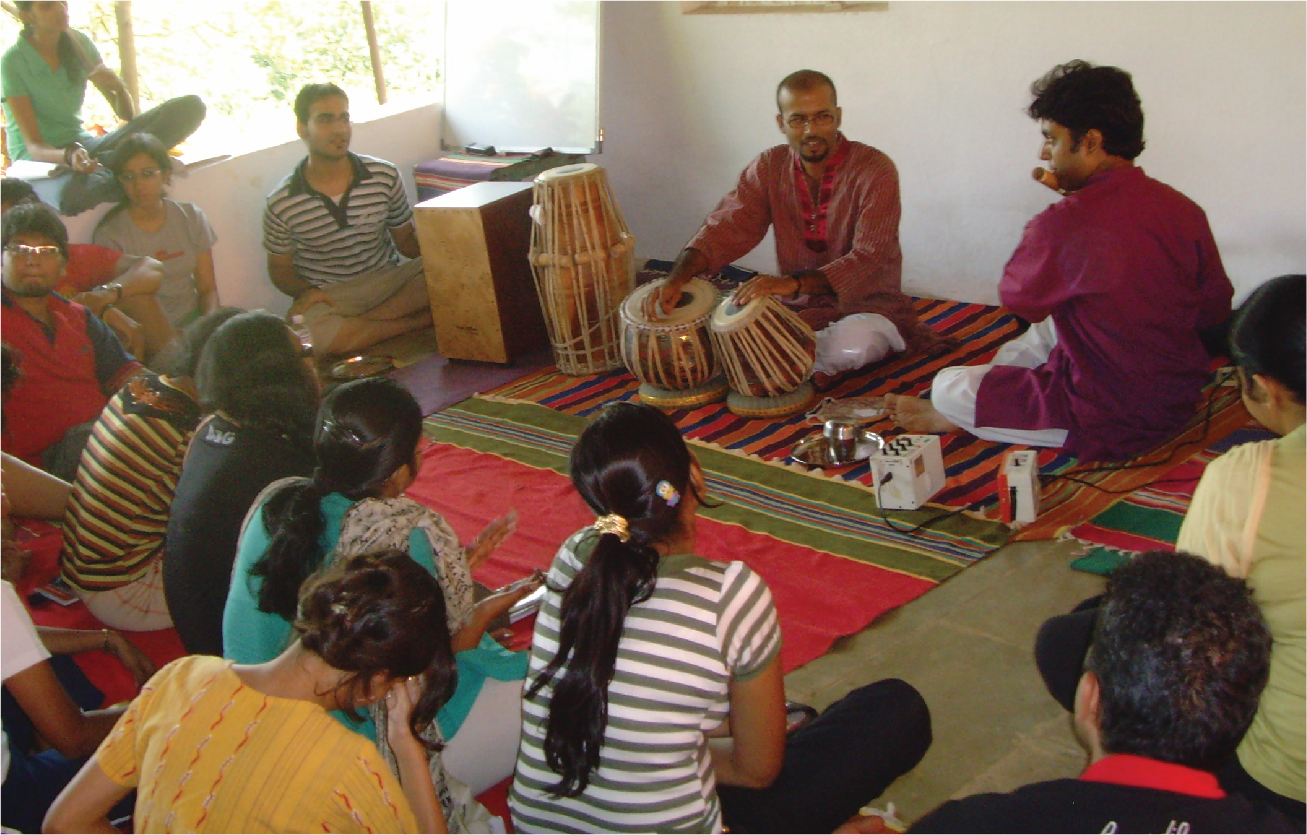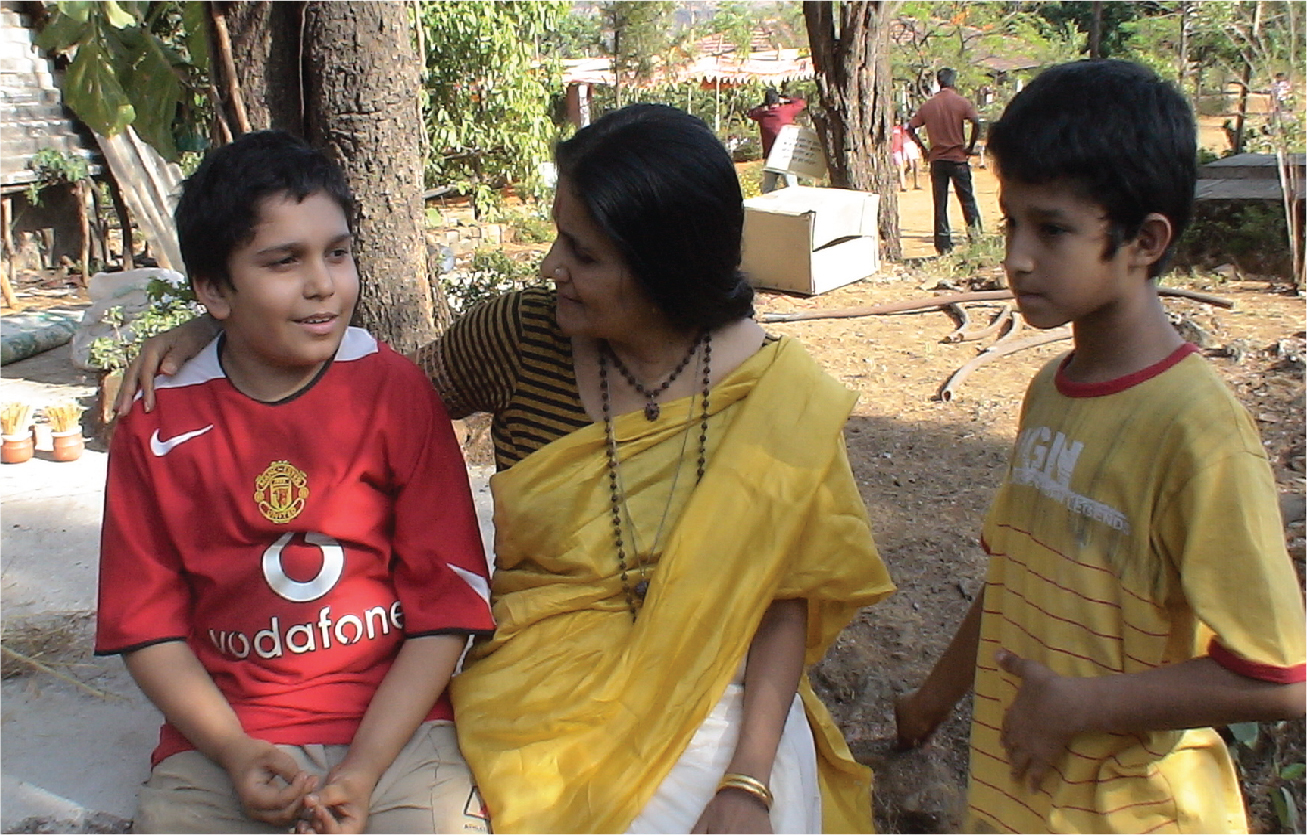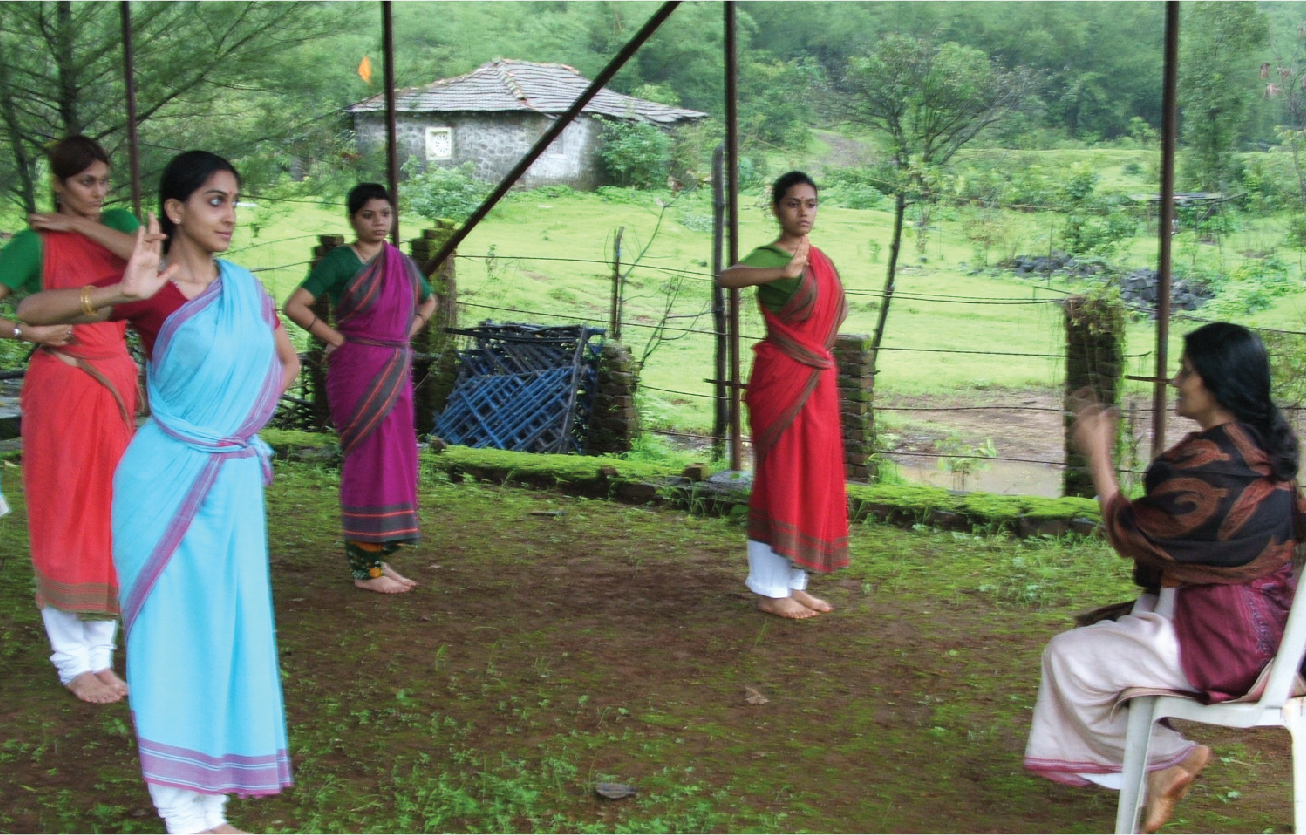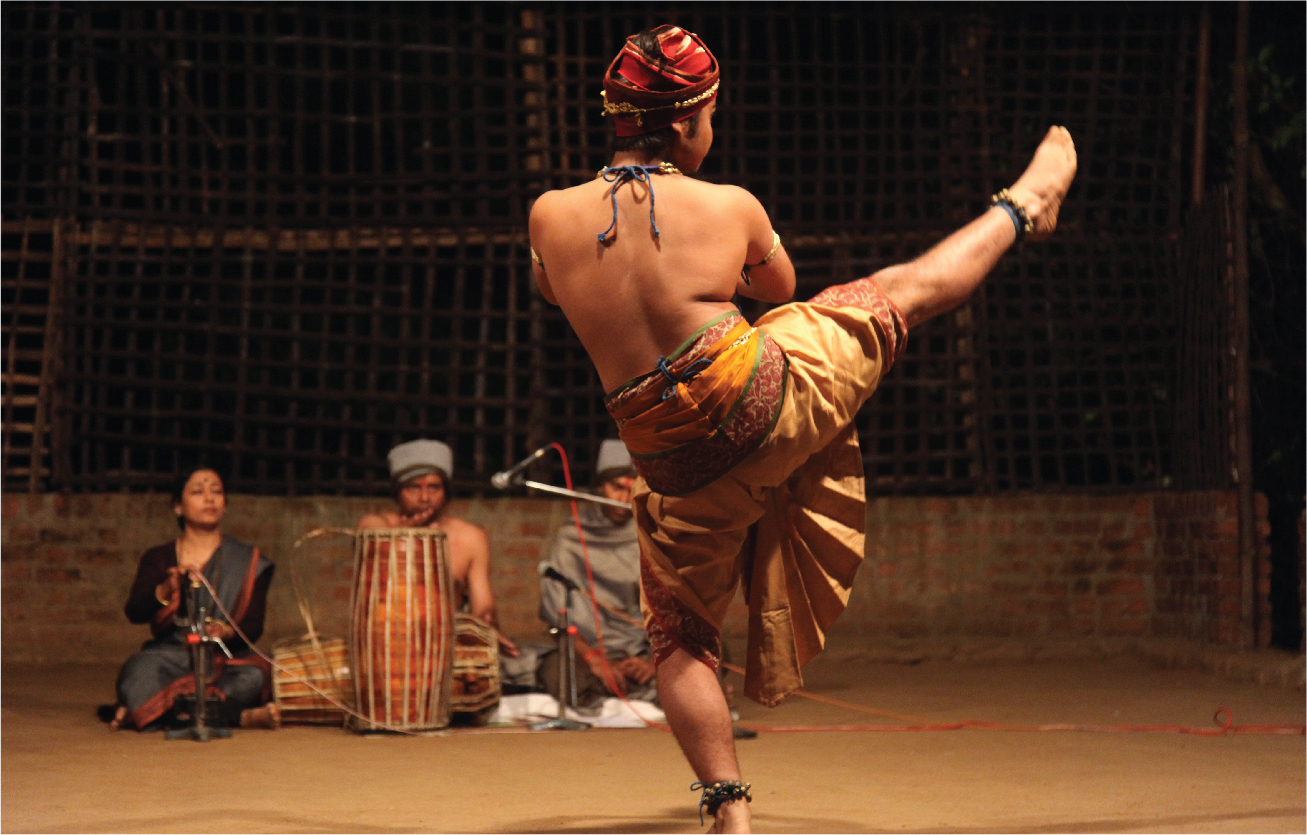Overview
Cultural rootedness is one of main values of education that the founder considered to be important. Only that which is firmly rooted can grow, spread and be inclusive. Unless we are culturally rooted we cannot be true global citizens. The Shaktiyogashrama Cultural Gurukul aims at understanding Indian cultural practices and arts not just as beautiful, decorative heirlooms from a distant past; but also as living traditions that embody the highest principles of Yoga. Cultural forms are an expression of a worldview and wisdom that can guide one through life. The study of the rich and aesthetic cultural forms of India will also sensitize a person to beauty; that in India is seen as akin to goodness and truth; that is Satyam Shivam Sundaram.
Programs

Cultural Awareness Experience
The Cultural Awareness Experience is meant to ‘Begin The Journey Within’.
The program is an integration of spirituality, classical arts, environment and lifestyles. it is a highly educative programs opening up unknown areas of the Indian cultural landscape to give the larger picture from which the ancient Indian arts, lifestyles and value systems emerged. The ashram gurukul atmosphere allows an intimate engagement with these subjects through which an authentic classical worldview can be lived, experienced, enjoyed.

The Children’s Camp
The urban children’s programme at the ashram is to fill in the gaps in the education system. It includes a gentle exposure to Indian arts, Indian culture & life styles. It is an introduction to the outdoors, to nature & rural life in a fun way. The ashram-gurukul experience sensitises them to the ‘Divine’while also giving a taste of community living that is missing in nuclear families.

Classical Indian Dance Gurukul
The Indian Dance gurukul with its leisurely, residential, gurukul structure gives the young dancer an opportunity to delve into the finer points of the art that a typical Indian Dance ‘hobby’class does not have the space for. Beginning with fitness & nutrition, it also encompasses the yogic concepts that are encased in its aesthetics. The spiritual disciplines at the ashram in the form of yoga, meditation & temple worship makes it possible for the dancers to ‘Walk The Talk’.
Thoughts
Indian art has been produced by professional craftsman…….. “In India the same qualities ervade all works, of any given period – from pottery to architecture, and all are equally expressive – the smallest fragment of a textile portrays the same as the most elaborate temple
In other words, there are no distinctions of fine and applied and decorative are and no surmountable barrier dividing the arts of the folk from the canonical arts…….
In these words, Dr. Anand Coomaraswamy, a great scholar, has assessed the traditional Indian Art…
Of the various genres of North Indian classical music, that known as dhrupad is generally regarded, by musicians, listeners and scholars, as the ‘oldest’ ‘purest’, ‘serious’ most ‘demanding’, ‘highest’, most ‘sacred’, and above all perhaps, most ‘traditional’. It is also generally assumed to be extinct, or at best moribund. Indeed, faced with the burgeoning popularity of other styles of classical or semi-classical vocal music-khyal, thumri, ghazal-and of instrumental music, to say nothing of film music, dhrupad retreated into semi-obscurity during the middle decades of this century. During this period, for example, commercial recordings of dhrupad could be numbered on the fingers of one hand. Nevertheless, during the las twenty years, dhrupad has reemerged from the shadows…
Kathikali is a luminous dance-drama and a classical pantomime which sustains exhilarating artistic aspects such as acting, music and rhytbm.
The word Kathakali means story-play. Elements of Kathakali are well perceivable in the ancient rituals of Hindu temples and others places of worship.
Various folk arts of Kerala like Theyyam, Padayani, Mudiyettu, etc. have influenced the origin and developments of Kathakali, apart from classical arts like Krishnanattam (a devotional dance-drama mainly performed at the precincts of Guruvayoor temple in Kerala) and Koodiyattam (the stylized Sanskrit theatre tradition which is more than 2000 yars old). The influence of Kalaripayattu, the martial art of Kerala, is also discernible in the training exercises and movements of Kathakali…
Bordering the north east corner of India enclaved by the mountain ranges, between Assam and Burma, lies the tiny state of Manipur. The Bamboo thickets and banana groves dotted by placid lakes and innumerable temples make it truly an abode of Gods. Since days bygone, in nature’s beauty and bounty, the people of Manipur have cultivated a life merged in music and dancing. They have celebration of social functions having ceremonies like birth of a child, annaprasan (i.e. giving food for the first time to a child), Karnabhed (piercing the ears) upanayan (tread ceremony) marriage and death in which they dance and sing. Truly they believe themselves to be the descendents of Gandharvas (the celestial musicians and dancers). This belief in the ancient myth and legend is a guiding and preserving force of the noble heritage of the art of Manipuri dancing in its pristine purity. These dance and music are associated with religion, thereby enabling men to commune with God and feel harmonious with nature…
The evolution of Kerala temple architecture can be traced to the residential architecture as evidenced by the common architectural style…
…The simplicity and the efficiency of the structures show the basic character of Kerala architecture Each structure, be it a Goppuram or Oottupura is functional.
All over India there is a distinct difference in the treatment of traditional residential and religious buildings. The residential buildings are comparatively smaller in size and conform to the human scale. They are visually subservient and simple in detailing. On the other ‘hand religious building are larger in scale, proportion and size. They visually dominate the skyline. The general planning of these built forms are also different. In contrast to this general convention, in Kerala traditional buildings, both residential and religious are comparable in size, scale, general planning, and arrangement and treatment of various spaces. The grandeur of the Gopurams and Ghharas which soar to the skies, large built up areas of Mandapas rich carving and decoration to the exterior and interiors of the walls of the temple complex from other parts of India are in sharp contrast to the simple structures, and simpler decorations of the kerala temples…
Whiled writing on Yoga and Music, Ayurveda and Music, Veda and Music some of the common issues have been already dealt with only the remaining ones, have been focused here.
Dharma-artha-kama-maksha set forth the ends of human life. They are said to be the four pillars of life with all its various activities. Any discipline has to anticipate them while formulating a system. All sciences, learnings and lores, are basically categorised under these in a general scheme of cultural praxis in India. Mantrashastra covers all these aspects of life. Every activity is accompanied by some rite, some mantra, in this or that form. Life has six phases in all – i) existence (asti), ii) birth (jayate), iii) grows (vardhate), iv) transforms or precipitates (viparinamate) v) decays (apakshiyate), vi) dies (mriyate). In man the very first stage “existence” is indicated by inception (conception) called garbhadhalla, which is accompanied by a mantra. Even the last stage, “death”, – end, on the thirteenth day of the death, is characterised by an appropriate mantra. These are coved under sanaskara, sixteen in number. Life in India thus begins, endures and ends with mantra. Mantra thus covers all the four ends of human life with its four corresponding ashrama format, Brahmacharya, (celibate), Grhastha (household), Vanaprastha (following the forest) and the sanyasa (renunciation)…
Indian music had developed over the millinea as a single system of music until about the thirteenth century after which it split into two similar but distinct systems the Hindustani music of North India and the Carnatic system of the South. Purandra Dasa (1484 – 1564) can be said to be the principal founder of the Carnatic system as we know it today. He codified the teaching have survived over the centuries and are in vogue even today. The next signif icant development in Dikshithar. Syama Sastry and Swat hi Thirunal…












